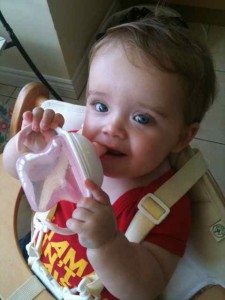Moving your little one on to a sippy cup – the easy way!
 Moving your little one on to a sippy cup can be quite a tricky time and something that little ones can take to right away, or may need lots of support and encouragement. Here I share my tips on making moving on to a sippy cup the easy way!
Moving your little one on to a sippy cup can be quite a tricky time and something that little ones can take to right away, or may need lots of support and encouragement. Here I share my tips on making moving on to a sippy cup the easy way!
What’s a sippy cup?
A sippy cup is a training cup for babies and toddlers. They come in all sorts of shapes, sizes and colours, but are usually made of plastic with a screw-on or pop-on lid that has a spout for drinking without spilling. some have handles for little hands to master, and some are handless with a bottle-like shape.
When should I move my baby to a sippy cup?
Babies are usually ready for a cup anywhere from around 6 to 8 months, but some babies are not interested until they are over 12 months. Go by your own baby – every child is different and there’s no exact age when they should start to try.
If your little one spends all day slurping on a bottle of milk or juice, it could lead to permanent damage and serious tooth decay. It also means there’s little room for all those nutricious and yummy baby foods at meal times.
Which sippy cup should I buy?
It’s a good idea to shop around as some sippy cups may be preferred by your little one than others. Start with a slow-flowing sippy cup that limits the flow of liquid from the cup.  This’ll make choking on fluid less likely (a common cause of cup rejection.)
This’ll make choking on fluid less likely (a common cause of cup rejection.)
There are lots of cups available and it’s really a matter of letting your little one try and test them. Every child is different, so what one bay may like another will really dislike!
How can I make the transition easy?
Many parents worry about moving their little ones from bottle to cup because of rejection worries. Often the comfort of breastfeeding or bottle feeding can cause issues with accepting a sippy cup, so it’s important not to make it a big deal, and just introduce the idea gently.
Try introducing the cup at lunch and tea time rather than breakfast when your little one is very hungry, and keep the evening milk before bed as a breast or bottle feed until they are a little older as it’s more comforting than a cup.
Dip dip!
Dip the tip of the cup spout into your baby’s breast milk or formula and then give it to your baby to try. sometimes something so simple works so well!
Show your little one the way: Little ones love to copy, so take a sip from a sippy cup yourself and offer your baby one for herself. Siblings come in really handy when introducing cups – let them help by showing their younger sibling how to drink ‘like a big girl’
Try different liquids: Some babies will only take water from a sippy cup, preferring the breast or bottle for breast milk or formula. Don’t worry – this is normal, just encourage regular tries of the cup. With 12 months and over, a sippy cup is a great way of introducing cows milk. You can warm it a little first – this often makes little ones accept sippy cups more easily.
Avoid high sugar drinks: It’s not advisable to encourage drinking juice if your little one is happy with milk or water from their sippy cup. Juice is one of the most common causes of tooth decay in little ones.
Whenever your little one is ready to move on to a sippy cup, these tips will help you move on the easy way!


Recent comments